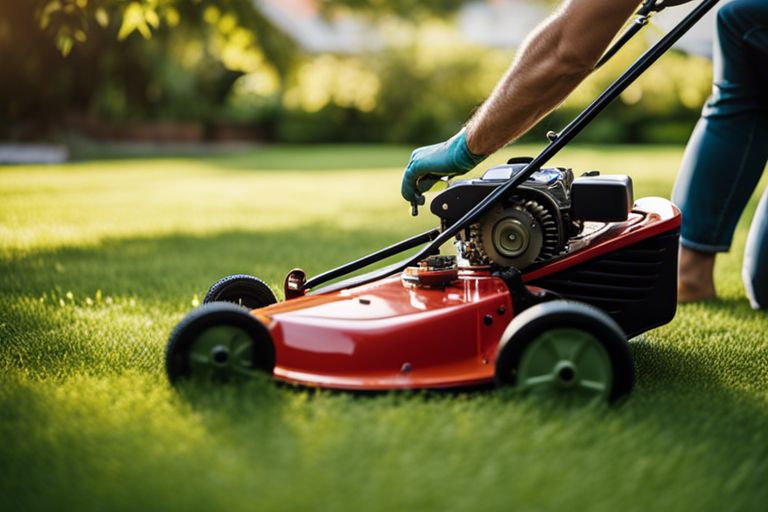There’s no need to be intimidated by the thought of changing the spark plug on your lawn mower. With the right tools and a few simple steps, you can easily tackle this task and keep your mower running smoothly. In this step-by-step guide, we will walk you through the process of changing the spark plug on your lawn mower so you can confidently maintain your equipment and ensure it’s in top working condition.

Key Takeaways:
- Use proper tools: Before changing the spark plug on a lawn mower, ensure you have the correct spark plug socket and wrench to remove the old plug and install the new one.
- Follow safety precautions: Always disconnect the spark plug wire before changing the spark plug to prevent accidental starts. It’s also a good idea to wear gloves and eye protection.
- Consult the owner’s manual: Each lawn mower model may have specific instructions for changing the spark plug. Refer to the owner’s manual for guidance on the type of spark plug needed and the torque specifications for installation.

Preparatory Steps
Gathering the Necessary Tools and Materials
While preparing to change the spark plug on your lawn mower, the first step is to gather all the necessary tools and materials. You will need a spark plug socket wrench, a socket extension (for hard-to-reach plugs), a new spark plug that matches your mower’s specifications, and a gap gauge to ensure proper spacing.
Safety Tips Before You Begin
Necessary precautions must be taken to ensure your safety before starting the spark plug replacement process. Even before touching the spark plug, remember to disconnect the spark plug wire to prevent accidental starting. Recognizing that lawn mowers can still carry an electrical charge even when turned off is crucial to avoid any accidents.
Even a seemingly simple task such as changing a spark plug requires strict adherence to safety measures. Recognizing the potential hazards and taking the necessary steps to mitigate them is necessary for a successful and safe maintenance process.
Removing the Old Spark Plug
Locating the Spark Plug
To successfully change the spark plug on your lawn mower, the first step is locating the spark plug itself. Typically, the spark plug can be found on the side of the engine block, under a rubber or plastic cap. It will have a thick wire attached to it, leading to the ignition system.
How-To: Safely Remove the Spark Plug
When removing the old spark plug, it is crucial to do so safely to prevent any damage to the engine or yourself. First, ensure the engine is cool before beginning the process. Using a spark plug socket wrench, carefully loosen the spark plug by turning it counterclockwise. Once loose, you can remove it by hand by twisting it out of the socket gently.
Recall, always refer to your lawn mower’s manual for specific instructions on how to properly remove the spark plug to avoid any potential issues. Safety should always be a top priority when working on any machinery.
Installing the New Spark Plug
Choosing the Right Spark Plug
For optimum performance, it is crucial to choose the correct spark plug for your lawn mower. Refer to your mower’s manual to determine the appropriate spark plug type and size. Make sure to select a spark plug from a reputable brand to ensure quality and reliability.
How-To: Properly Install the New Spark Plug
Any time you are replacing a spark plug on your lawn mower, it is vital to follow proper installation procedures to prevent damage and ensure optimal performance. Start by carefully threading the new spark plug into the spark plug socket and gently hand-tighten it. Use a torque wrench to tighten the spark plug to the manufacturer’s recommended torque specification.
The torque specification can typically be found in the mower’s manual or on the spark plug packaging. Over-tightening the spark plug can cause it to seize or break, while under-tightening can result in poor performance and inefficient combustion. Once the spark plug is properly installed, carefully reattach the spark plug wire and any other components that were removed during the process.
Post-Installation Checks
Ensuring the Correct Spark Plug Gap
Many are unaware that the spark plug gap plays a crucial role in the efficiency of your lawn mower. With the spark plug installed, use a feeler gauge to ensure the gap matches the manufacturer’s specifications. A proper gap ensures optimal ignition and prevents issues like misfires or engine knocking.
Factors Influencing Optimal Spark Plug Performance
Many factors can influence the performance of your spark plug. One critical factor is the type of fuel you use. With the correct fuel-to-air ratio, your spark plug will burn fuel efficiently. Another factor is the engine temperature, as a cool engine may cause fouling, while a hot engine may lead to pre-ignition. Regular maintenance and cleaning of the spark plug and its components can also impact its longevity and performance.
- Ensure the fuel-to-air ratio is correct for optimal performance.
- Maintain the engine temperature within the recommended range for the spark plug to function effectively.
- Regularly clean and inspect the spark plug to prevent issues and extend its lifespan.
Plus, it’s necessary to consider the age and condition of your lawn mower when assessing spark plug performance. You may need to adjust the spark plug gap more frequently if your mower is older or experiences heavy use. Thou should always refer to the manufacturer’s guidelines for the most accurate information on spark plug maintenance.

Maintenance Tips
After changing the spark plug on your lawn mower, it’s necessary to follow some maintenance tips to ensure its longevity and optimal performance.
- Regularly clean the air filter to prevent debris from clogging the engine.
- Check the oil level and change it as recommended by the manufacturer.
- Inspect the blades for wear and tear, and sharpen or replace them as needed.
Knowing how to properly maintain your lawn mower will not only extend its lifespan but also keep it running smoothly for years to come.
How-To: Maintain Your Lawn Mower’s Spark Plug
Spark plugs play a crucial role in the ignition process of your lawn mower. To maintain your spark plug, regularly remove it, inspect for any build-up or damage, and clean or replace it if necessary. Keeping the spark plug in good condition will ensure that your mower starts easily and runs efficiently.
When to Replace the Spark Plug: Recognizing the Signs
Spark plugs wear out over time, leading to poor engine performance and difficulty starting your lawn mower. Signs that indicate it’s time to replace the spark plug include rough idling, problems starting the mower, and decreased fuel efficiency. By recognizing these signs and promptly replacing the spark plug, you can prevent further damage to your lawn mower.
With regular inspection and proper maintenance, you can ensure that your lawn mower’s spark plug is in top condition, leading to better performance and a longer lifespan for your equipment.
Conclusion
Now that you have learned how to change the spark plug on a lawn mower, you can ensure your equipment operates efficiently and effectively. By following the simple steps outlined in this guide, you can easily maintain your lawn mower and keep your yard looking its best. Do not forget, regular maintenance, such as changing the spark plug, is imperative for the longevity and performance of your lawn mower. So don’t hesitate to take the time to perform this simple but crucial task.
FAQ
Q: Why is it important to change the spark plug on a lawn mower?
A: Changing the spark plug on a lawn mower is crucial for proper engine performance and efficiency. A worn-out spark plug can lead to issues like hard starting, poor fuel economy, and rough idling.
Q: How often should I change the spark plug on my lawn mower?
A: It is recommended to change the spark plug on your lawn mower at least once a year or after every 100 hours of use. However, if you notice any signs of wear or performance issues, it is best to replace it sooner.
Q: What tools do I need to change the spark plug on a lawn mower?
A: To change the spark plug on a lawn mower, you will need a socket wrench or spark plug socket, a gap gauge, and a new spark plug that is compatible with your mower’s engine model.
Q: How do I know if the spark plug on my lawn mower needs to be changed?
A: Signs that indicate a worn-out spark plug include difficulty starting the engine, rough idling, poor acceleration, and decreased fuel efficiency. Inspecting the spark plug for signs of wear, such as deposits or corrosion, can also help determine if it needs to be replaced.
Q: What is the proper way to change the spark plug on a lawn mower?
A: To change the spark plug on a lawn mower, first, disconnect the spark plug wire. Then, use a socket wrench or spark plug socket to remove the old spark plug. Check the gap on the new spark plug using a gap gauge, and adjust if necessary. Finally, install the new spark plug by hand tightening it and then using the socket wrench to secure it. Reconnect the spark plug wire, and you’re done!
